The ancient language of ivrit ( עברית ) - Zayin - Vowels & Reading
Like the Alfabet, The letters in Hebrew are called the Alef - Beyt They are presented on my blog from bottom to the top so you can learn them order, then to read them right to left. You will see what the original "Bible" said and what the names meant as they went through the stories of old.
This is an important lesson
- One new letter
- A look at all the vowels, and their sounds
- The left to right reading pattern
- And some snapshots of words from the Tanakh
Let's compare Zayin to Vav
On the left we see Zayin: Symbolizing a sword or a weapon.
It's the seventh letter. It is a consonant. It is also the number 7 when used as a number.
- The sound this letter makes when pronounced is just like "Z" in "zoo"
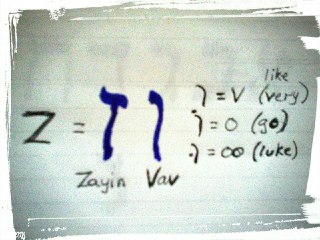
On the right we see Vav, which can be a consonant, a vowel, or a consonant with a vowel impacting its sound.
Above you can see three samples of Vav
- v as in "very"
- o as in "owe"
- oo as in "luke " or "boot"
Vowels
There is no need to concentrate on the names of the vowels. I had actually forgotten the names - I never use them except to teach. You will easily learn the sounds of the vowels as you go. That is what is important and quite easy.
Below is a chart of the Niqqudim (vowels). By now, you are familiar with five of them. The other four can be learned as we go. The second one is "Shva" and it has almost no sound - it's short and indistinct. Let's say its sound is " - " and for the others, I will write a word that contains their sound above and below each vowel in the image (separated with : . : for spacing).
OWE : . : " - " : . : PAY : . : HATE : . : BLA : . : BLAH
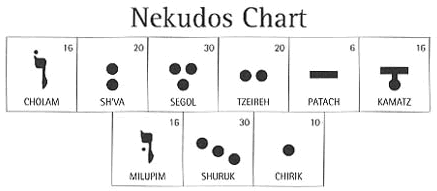
: . : : . : SHOE : . : SMOOTH : . : MEET(if under)
source
The single dot (chirik) sounds like "ee" if it appears under a letter
If the single dot appears above a letter it sounds like "owe" (and so does cholam)
I will do a more in depth lesson on the sound of each Niqqud in other lessons.
Reading in Hebrew is not quite right to left.
I will explain reading. It is read in a shark-tooth or, wave pattern, right to left while encountering the vowel and consonant sounds as we go. Below I have written the word.
Bah Bay Bee Boe Boo
It's not a real word but here is how we find the B sounds and the vowel sounds that are found after (below or above) each "Bet". The numbers represent each sound in the order they should be found and pronounced.
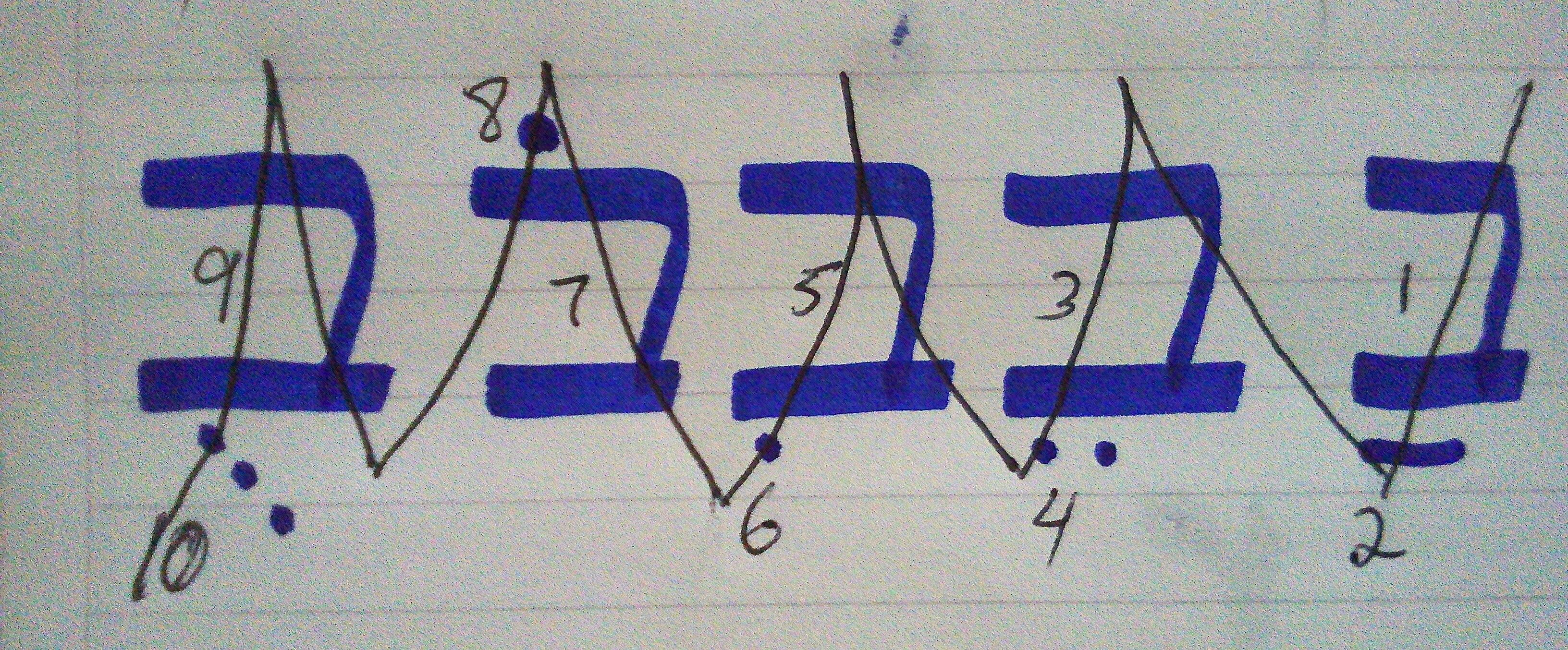
Starting at the top right we find consonants and vowels in this order...
1 and 2 = Bah on a down-left motion with our eyes.
3 and 4 = Bay on a down-left motion
5 and 6 = Bee on a down-left motion
7 and 8 = Boe on an UPWARD left motion
no vowel is found on the next down-left motion
9 and 10 = a Boo on a down-left motion
This is the simplest of explanations that I can make in order to get you started. Now let's start reading some words using the letters you already know.
Practice
Here is where I add meaning to these lessons. Let's read together and learn some words clipped right out of my Tanakh (Bible). Please use the same type of motion to find your sounds. The English meaning appears below each Hebrew word.
O or Owe = Or

Who or Hoo = He

Followed by Milupim (Vav with a dot left of it) - "'oo"
The Aleph which is silent (no vowel with it)
He or Hee = She

Under "He" there is a dot (Chirik) which sounds liek "ee"
Vav is a silent vowel here
Aleph is a silent vowel here. The colon is punctuation
V-ayzov = and hyssop

Next: Aleph (silent) with two dots under it (a Tzeireh) - sounds like "ay"
Then moving upward, Zayin with a dot above it = "zo" or "zoe"
Finally we have a Bet (with no dot in the middle) sounds like "V"
The colon is punctuation
voe or voh = "in him" or "on him"

These are two words, put together for to say "on him"
Note: there are other markings that you see in the clippings from the Tanakh - these are called Cantillation marks and are used in order to recite (almost like a chant or song) Hebrew aloud. They are usually not included in children's books and literature other than the Tenakh
Thanks for taking the time to read.
I like how you show that "on him / in him" indicates that the letter Bet means "in/on" .... as in the 1st word of the Torah B'ReShiTh.... In Beginning
You are on fire!
Fun fact: Every book in the Tanakh is named after the first word used in that book.
There is a word for "him" that is the direct object (circled in green below). Other times, "him" is just a vav at the end (indicated in blue).
Here is the Bible I have been reading for many years. I believe it to be the most accurate for learning as you go. I think you can download it free.
https://archive.org/details/ESVInterlinearOT
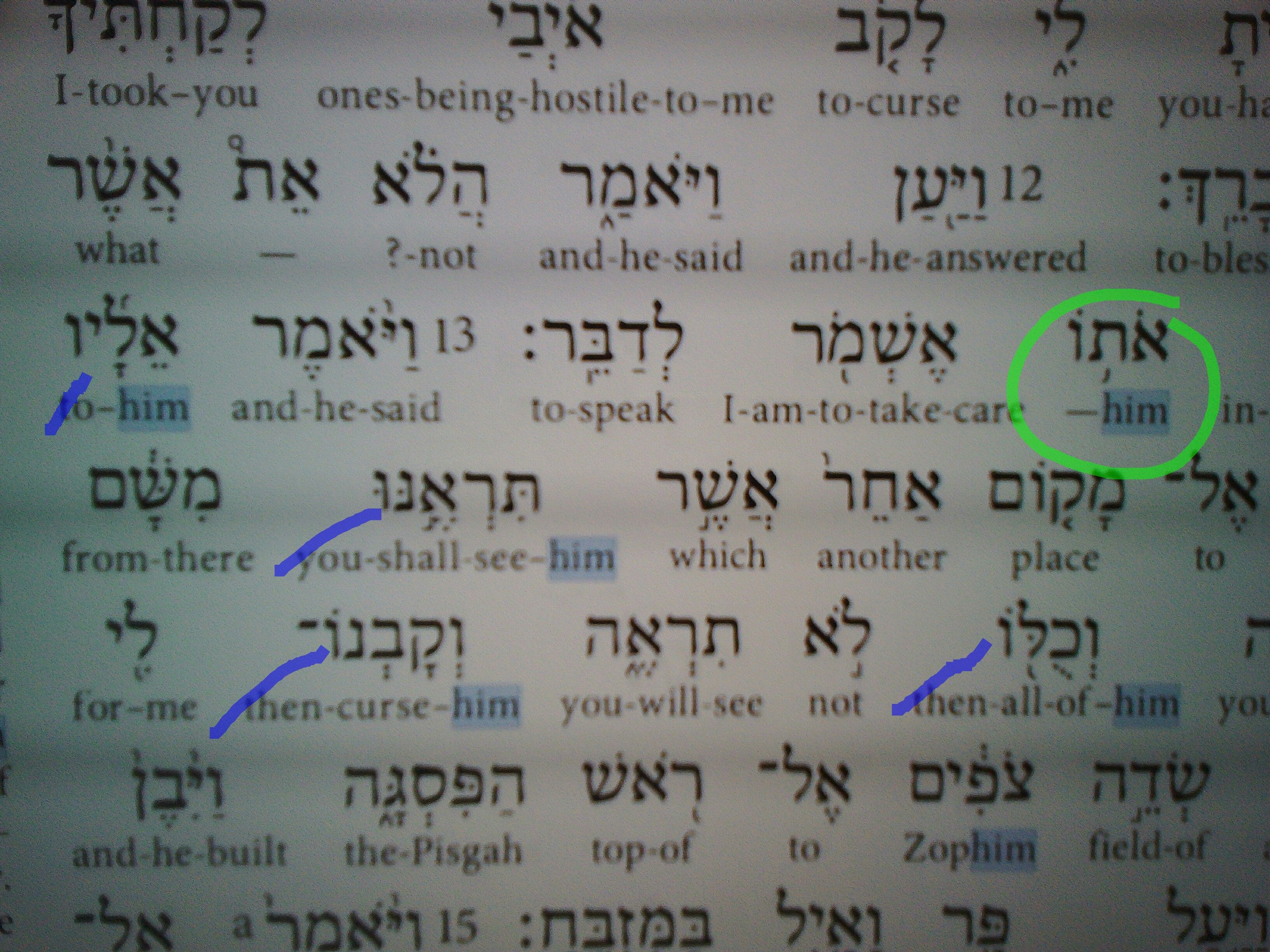
LOL "You are on fire!"
learning languages is fascinating. and how they communicate differently, but in the end the same emotions and feelings
Excellent... I am so happy to have found you here on Steemit. I needed a Teacher.
I studied your passed lessons very well. Someone tough task to be learned. But I`ll get full try study ancient language of ivrit. I think your blogs really assistance for me and other steemit users.
Thank you very much my friend @hebrew.
Upvotes and resteem!
@hebrew,
"Fun fact: Every book in the Tanakh is named after the first word used in that book."
That's amazing :D How could that be happened! First world in the book used to name the book :D
It's definitely a fun fact!
Cheers~
Its tute sir
You are making good friends comments and receiving updates from @done and @hebrew
Excellent - Just what I needed. Up-Voted and Resteemed. I'm here as your student... Elisha to Elijah. I will have a lot of questions for you. This post is jam packed with information - I love that you read the Hebrew words like riding a wave... like particles of Light.
So from "and hyssop" we see that vav also means "and" .... I learned this from the 1st line of the Torah
V with a Shvah under it usually means "and".
I forgot to add "The gold"
read it ...
Ha
za
hav
Ha = The
Zahav = gold
Excellent.... Moses uses a lot of Zahav to build the Ark and the Mishkan...
I prospect for ha zahav here in Canada....
Thank my Friend :)
Great learning. Resteemed. so more people know her
@hebrew
This is more difficult to grasp than I thought. I will retry tomorrow when I wake up fresh with my mental capacity at 100.% :p
I might have put too much in one lesson. For that reason I did not put up a vowel chart first lesson. But really, there are only a few vowel sounds. Ah, Ay, Ee Owe and Ooo - like in Spanish. and left to right works great as long as the vowels are under each letter.
Thanks for the opinion. It helps me do better.
ok I read again today. It was hard, but it made more sense ^__^
Very good lesson ... upvoted ! I like how you compare the letters to objects that we can remember. Zayin the sword.
The meanings for Hebrew letters were determined around or before they were scratched onto rocks. Generally as a rule, the first word that begins with the first occurrence of any letter lends the greatest weight to its meaning.
Thanks. I see that now from the images you have posted. This is extremely interesting. So happy to learn this very ancient language.
How old is the Hebrew Aleph Bet ? Is Aramaic older ? What is the earliest date for the symbols scratched on rocks ? 5778 years ago ? Earlier ?
Lots of questions.
Here is some of the very oldest...
I recognize a Mem and a He here and there. There are charts where "scientists" guess the age of these things.
Here is one of the rocks at the food of Mt. Jebel wher Moses was told to bring the children of Israel "back to this same mountain" when he was living in median. And he brought them back to that same mountain which is still scorched black to this day.
Fantastic. Thanks so much .... sorry for so many questions but I am thirsty to learn all I can about this beautiful language of the Torah
It's a thirst for everything we can all learn about this beautiful language.
That is very True.... a thirst to understand God Himself
https://www.pinterest.com/pin/38562140539468068
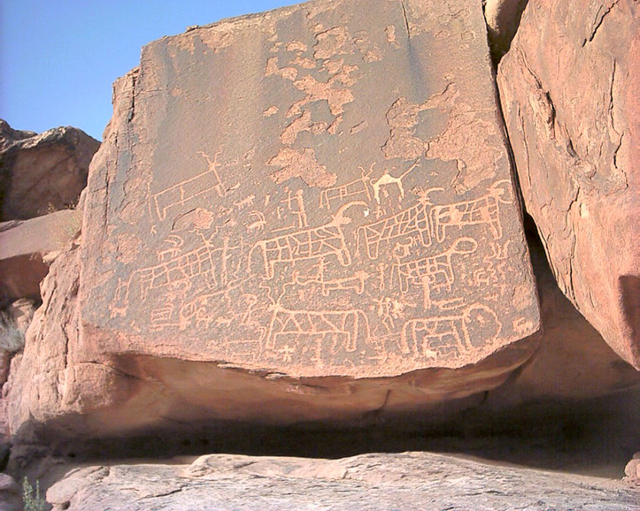
Does this cover both vav and zayin ( 6 + 7) then ? Or do I go back to the Dalet post for Vav? Great posts. Upvoted and resteemed.
I covered Vav on the one that has David as the cover picture. I could not wait to start on words so I jumped ahead. My bad!
Thanks for the vote of confidence.
Thanks @hebrew and @shadflyfilms I think that vav is a very important letter. Interesting that the pictographs show vav as a tent peg and zayin as a sword .... do the symbols come from an earlier proto Hebrew or earlier Aleph Bet?
very interesting post as always!
פוסט מרתק כרגיל!
Very good lesson. The Vowels I find confusing. This helps me so much. Thank you - UpVoted and Resteemed..
Me too.......... So many dots. This post helped me a lot too. This is a great way to learn this ancient Language. One letter at a time. I have spent years studying the Aleph alone.
Is very interesting go learning hebrew with you a little word for share is great for me, I consider hebrew the first languaje on the world.